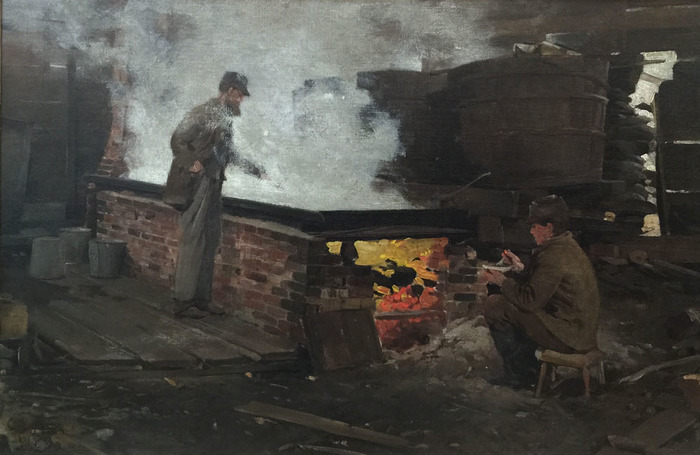Born in Hillsboro, Ohio, Charles Fries was referred to as the dean of San Diego artists from the time he settled in that city in 1897. His reputation was based on magnificent atmospheric desert landscapes, many of them showing historical scenes of the state.
He was raised in Cincinnati and apprenticed there to a lithographer and then studied portraiture at McMicken Art Academy where he associated with other men who became famous artists--J.H. Twachtman, Robert Blum, Kenyon Cox, and Frank Duveneck. He traveled from his Cincinnati studio to sketch in the Southwest, and his lithographs of these travels appeared in "Harper's," "Leslie's," and "Century" magazines.
When he was seventeen years old, he began working in New York City as an illustrator and portrait painter, and five years later, he went to Europe for art study and received many laudatory reviews in Paris journals for his painting. In 1887, he returned to the United States, married and lived on a farm in Vermont, and then moved to California in 1896.
He and his family lived briefly in the ruins of San Juan Capistrano, before building an adobe house and studio in San Diego. An avid bicyclist with a Van Dyke beard, flowing black tie, gentle manner, and twinkling eyes, he was a memorable sight with his painting gear in his basket. His journal records seventeen hundred California oil paintings, many of them with eucalyptus trees, and he was highly successful there also as a lithographer.
His many illustrations for magazines and text books included "McGuffey Readers" and the "Illustrated School History of the United States."
Source:
Edan Hughes, "Artists in California"
Biography from Gallery West
Charles Arthur Fries, illustrator, painter and teacher, was born in Hillsboro, Ohio, August 14, 1854. Raised in Cincinnati, he attended the Art Academy there at a time when it was considered one of the most notable in the United States. Among his fellow students were J. H. Twachtman, Robert Blumen, and Kenyon Cox. After marrying in 1887, he moved his studio to New York City where he was popular as an illustrator and portraitist while living on a farm in Vermont. In 1896 the Fries family headed west and, upon arriving in Southern California, temporarily lived in the ruins of the unrestored mission at San Juan Capistrano. The artist established himself in San Diego in 1897. Sporting a Van Dyke beard and flowing black bow tie, he was often seen riding about San Diego on his bicycle with painting gear in its basket. Fries was later referred to as the "Dean of San Diego Painters". He devoted his canvases to landscape painting and focused on the desert, the mountains, and eucalyptus trees. His works are sound in craftsmanship and bright in atmospheric light. He died December 15, 1940. A memorial exhibition was held at the Fine Arts Gallery of San Diego in 1941.
[by Martin E. Petersen, Curator of Western Arts at the Fine Arts Gallery of San Diego.]
Charles Arthur Fries was a member: San Diego Art Guild; Laguna Beach AA; La Jolla AA; Calif. Art Club; San Diego Contemporary Artists. Exhibited: California State Fair, 1930; California Pacific International Exposition, San Diego 1935; GGIE, 1939, Awards: silver medal, Seattle Fine Arts Society, 1911; silver medal, Panama-California Exposition, San Diego, 1915. His works are held by the San Diego Museum of Art and the San Diego Historical Society.
---From the Journal of San Diego History
Biography from William A. Karges Fine Art - Santa MonicaCharles Arthur Fries was born in Hillsboro, Ohio, in 1854, and was apprenticed to a lithographer in Cincinnati at the age of 15. While there he studied at the McMicken Art Academy. In 1887 Fries moved to New York, where he enjoyed a successful career in illustration before moving to California in 1896, settling in San Diego.
In California Fries concentrated on his atmospheric land and desertscapes. A prolific artist, Fries is remembered as being a major figure in the early San Diego art scene.
